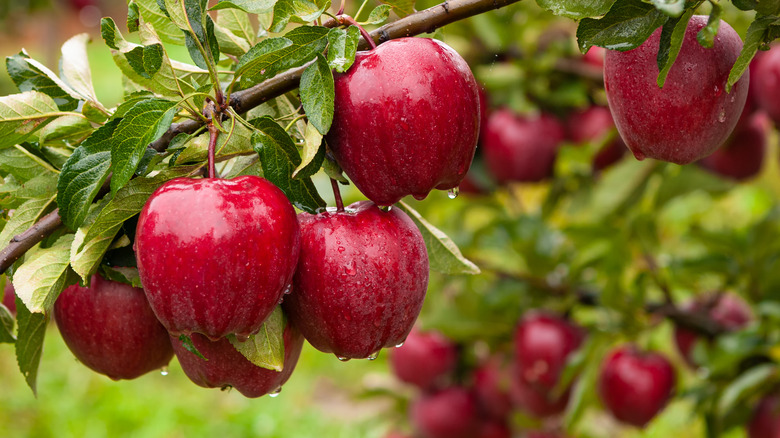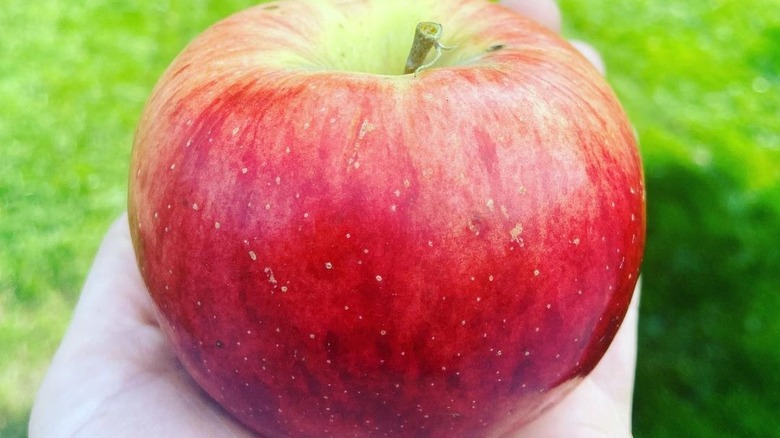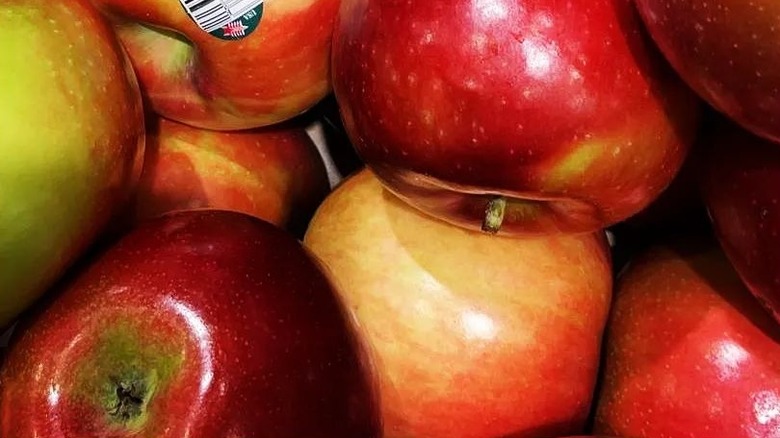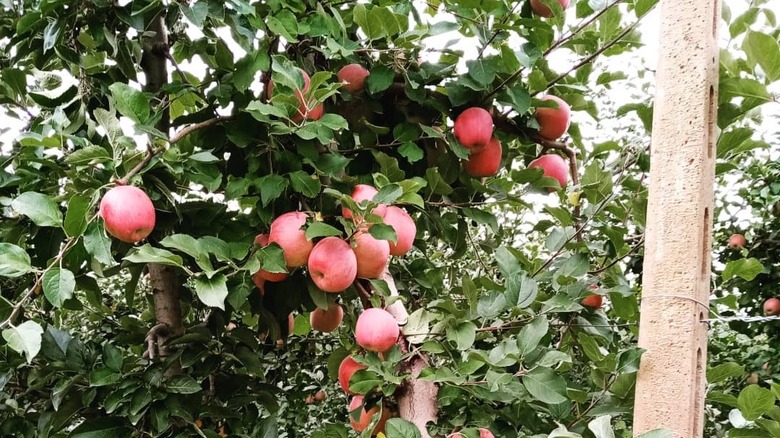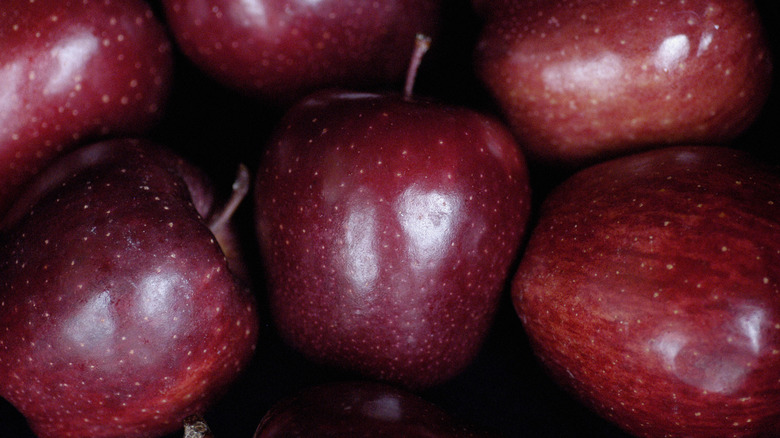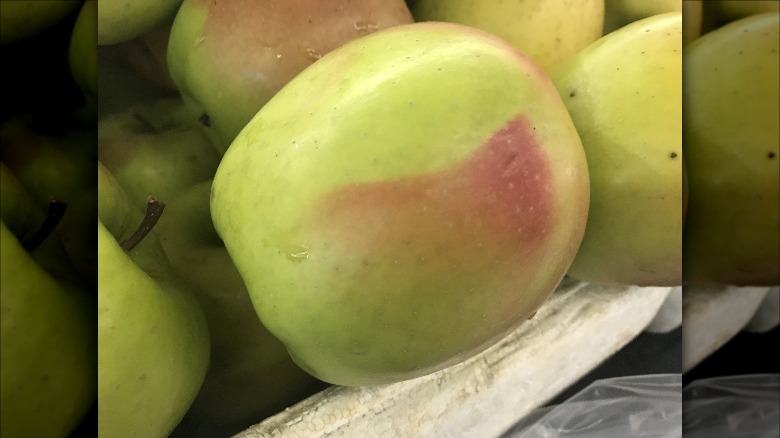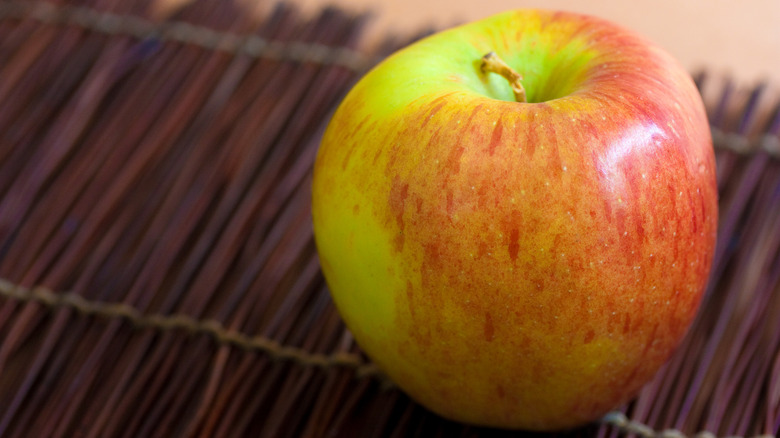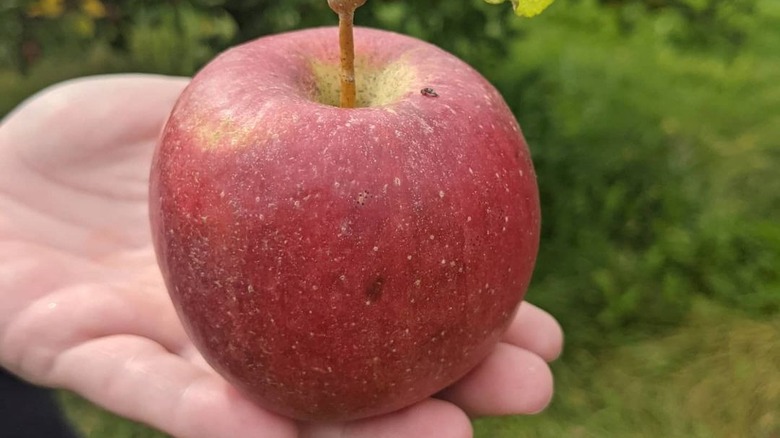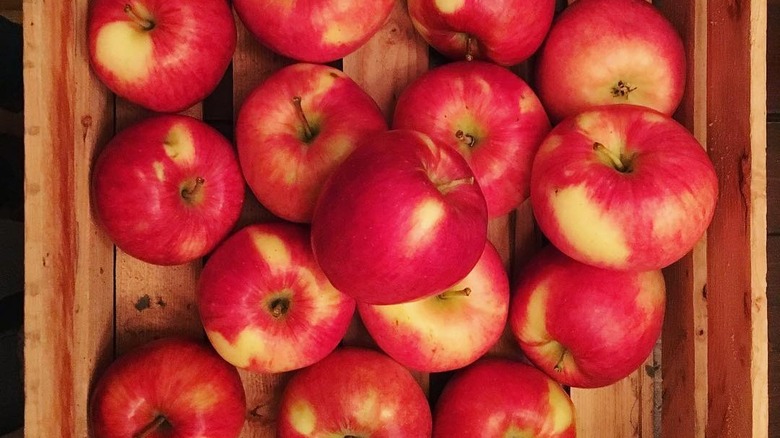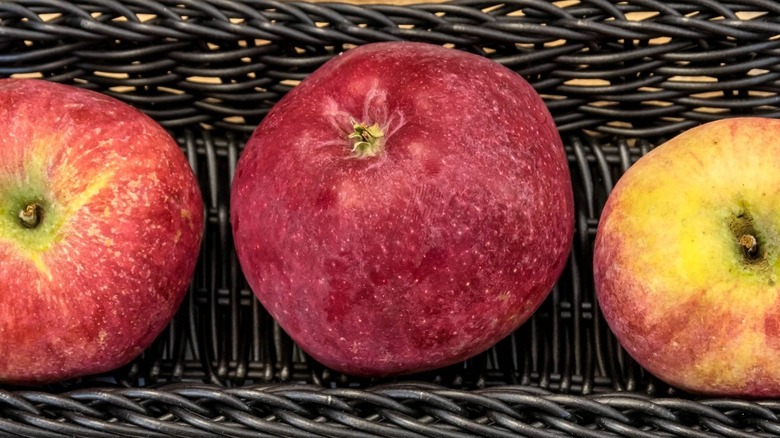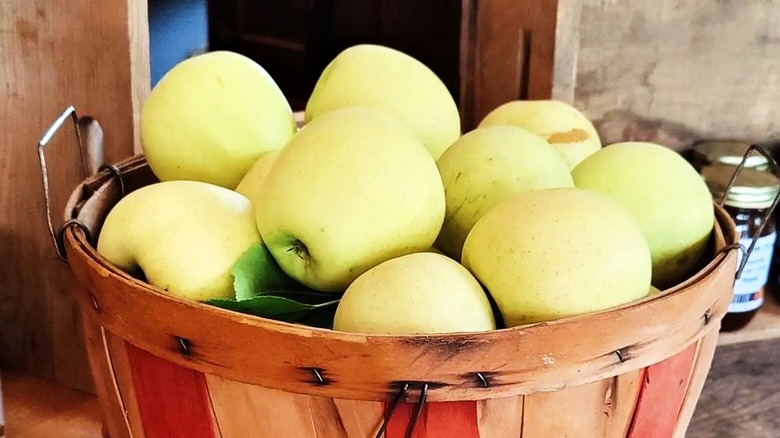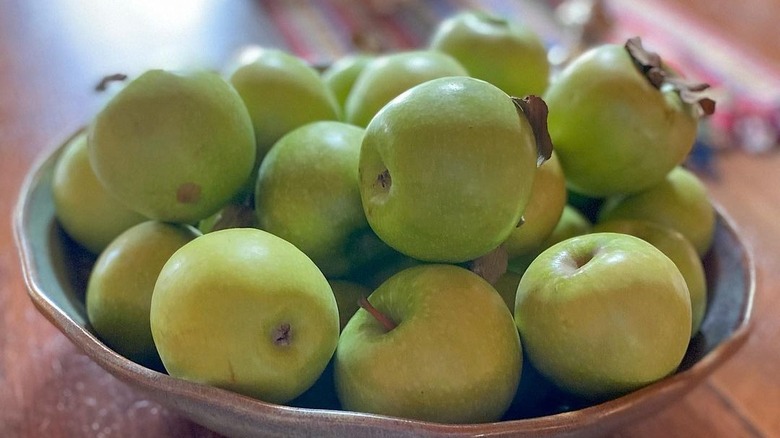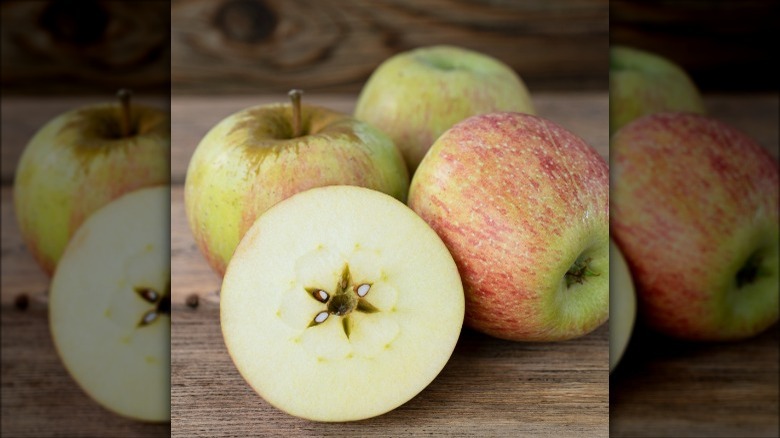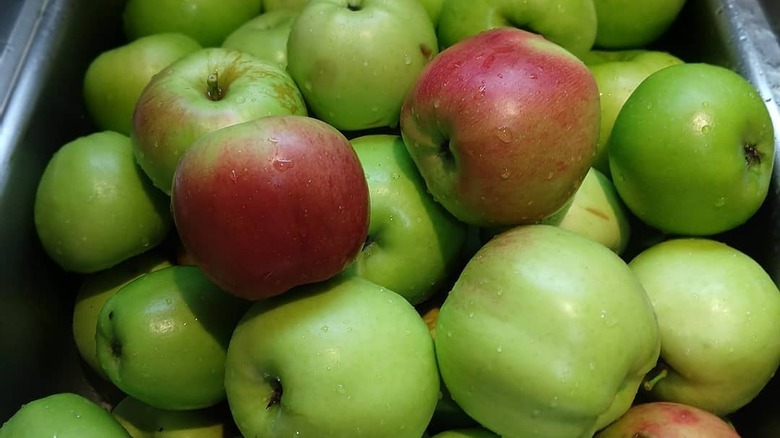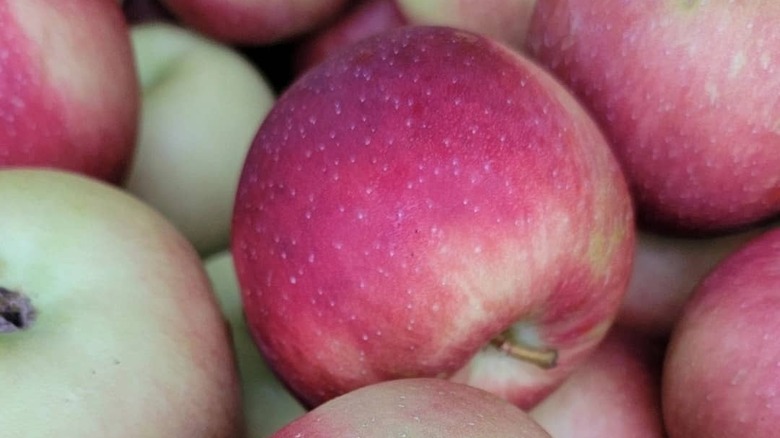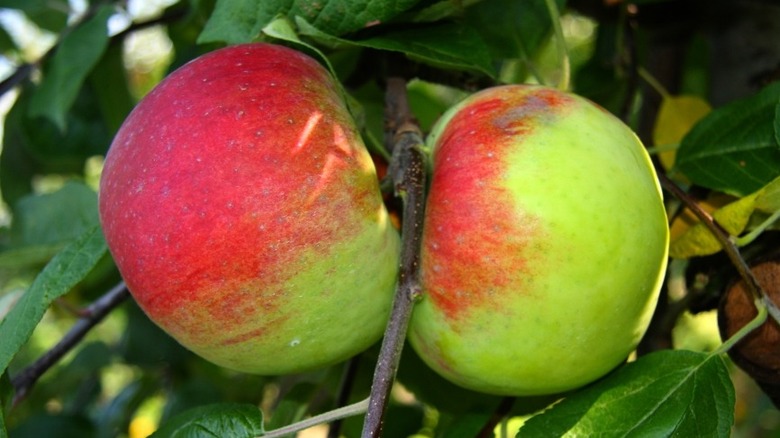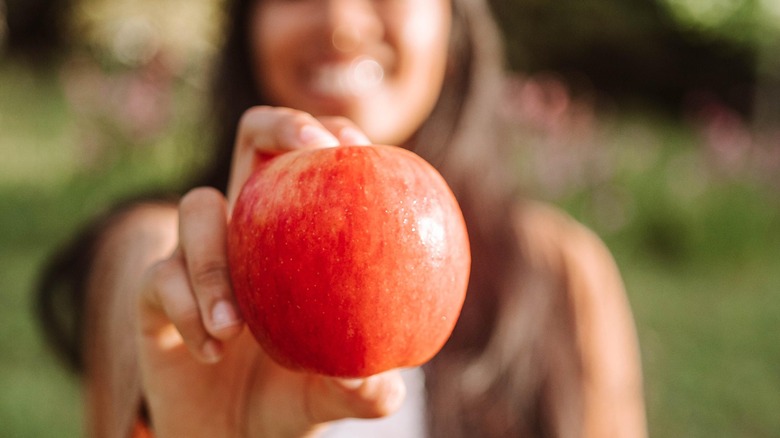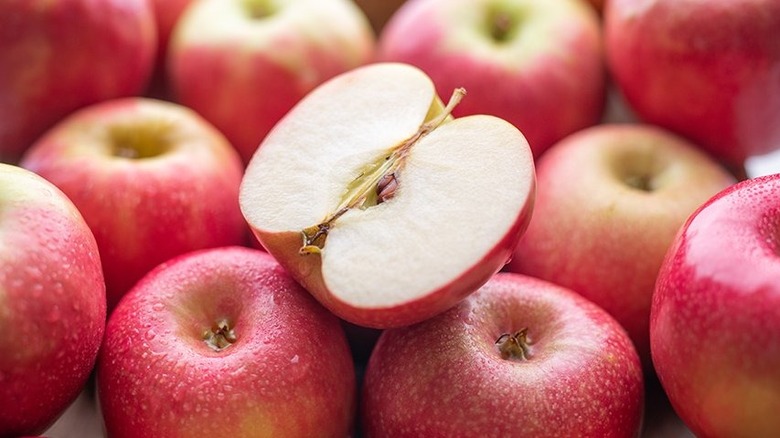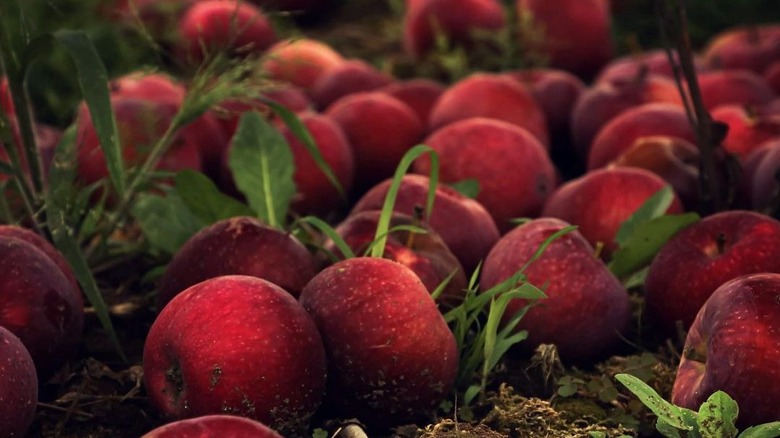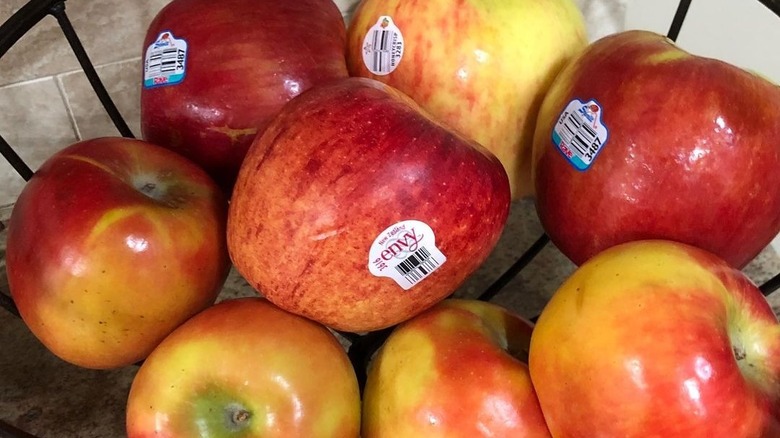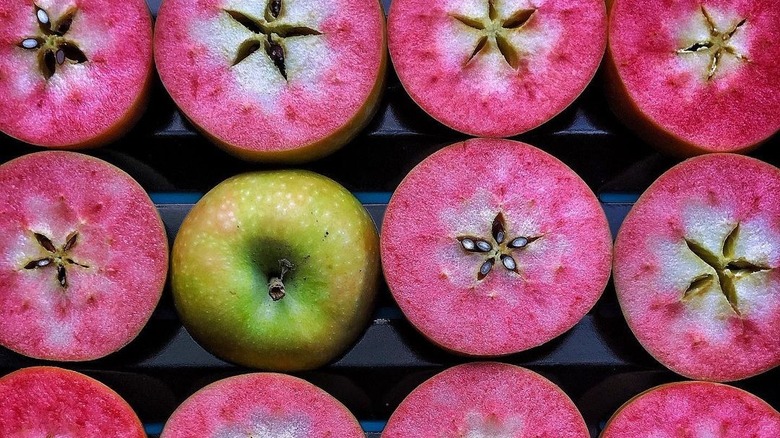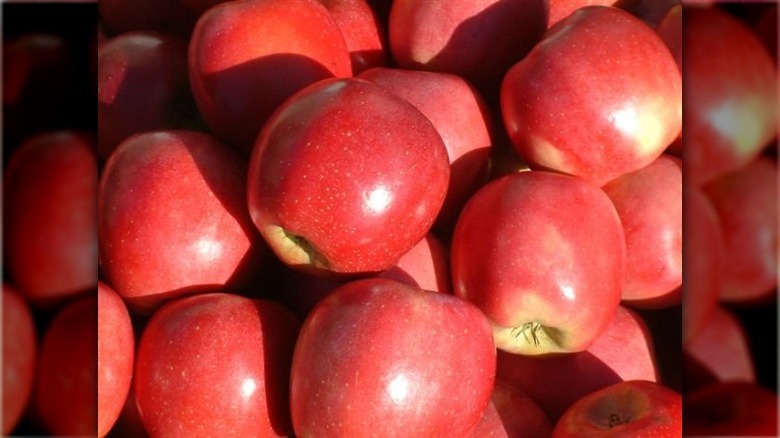21 Popular Types Of Apples And What They're Used For
Fall has arrived for much of the U.S., and with it comes pumpkin patches, haunted houses — and apple picking. Visiting orchards can be a great way to not just enjoy a fun fall afternoon, but also to try some new and delicious apple varieties that you might not find at your local grocery store.
The most popular apple variety in American today is the Gala, says HGTV, though the ubiquitous Red Delicious and Granny Smith apples aren't all that far behind. These apples and more aren't just popular in the U.S., either. In fact, they're grown around the world, which means that you can probably enjoy them fresh from your grocery store anytime, even when they aren't strictly in season in your area.
Whether you're hoping to hit up an orchard this fall or just want to know what varieties to look for on your next trip to the store, let's take a look at some popular types of apples available today, and what you can use them for.
Gala
As we've already mentioned, Gala apples are the most popular variety of apples in the U.S. today. In recent years, it beat out Red Delicious, which had held the title for decades. This is thanks mostly to its sweet taste and crunchy finish.
In addition to being the most popular variety, Gala apples are also one of the most widely grown in the world. They're grown in orchards in both hemispheres, which means that they are easy to find year-round. Compared to other apple varieties, Gala is a newcomer in the U.S., given that they weren't introduced to the market until the 1970s, reports Stemilt, though they were created in New Zealand in the 1930s.
In North America, Gala apples are harvested starting in mid-August and lasting into September (via SFGate). These apples are dense and hardy, which means that they hold up well for baking and cooking. But with a sweet taste and floral aroma, they're also great for eating fresh or chopping for salads.
Depending on how ripe your Gala apples are when you purchase them and the humidity in your home, Gala apples will last 1 to 3 weeks in your pantry, and up to 2 months in the fridge.
McIntosh
Unlike Galas, McIntosh isn't a new addition to grocery store produce sections. According to the Canadian Encyclopedia, this tasty apple variety was created in 1811 by a farmer named, of course, John McIntosh. Searching for apples in an overgrown portion of his Ontario orchard, McIntosh discovered the apple and set about cultivating it. Today, Taste Atlas says that it is one of the top 10 most popular apples in the world.
McIntosh apples are softer than many other varieties. As a result, they bruise easily and last just a few days at room temperature. Kept in the fridge they'll last longer. But if your apples have gone past their prime, McIntosh apples are perfect for making apple sauce or cider, as they break down easily and cook quickly. With a tart and tangy flavor, they're also great for enjoying fresh, though they don't hold up well for baking.
While McIntosh apples are available year-round in grocery stores if you want to find them locally, look for them to be in season from late fall to early winter, though some varieties of McIntosh are harvested starting as early as July.
Fuji
On the opposite end of the spectrum from McIntosh apples, Fuji apples are dense and durable and, according to AllRecipes, hold up especially well for baking into pies and cobblers. They also have a high sugar content that makes for tasty desserts, ciders, and sauces.
This popular apple variety first became widely available in the U.S. in the 1980s but was created in Japan in the 1930s, per Speciality Produce. They were developed at a branch of the Tohoku Research Station and are a cross between Ralls Janet and Red Delicious apples. The former, while no longer widely available, was cultivated by Thomas Jefferson – he of early American french fry and macaroni fame — at his Monticello home (via Minnetonka Apple Orchards). After being created, they went through years of trial and testing before being released for production.
In North America, Fuji apples are usually in season in late October, though like many apples on this list, you'll likely find them in your local grocery store year-round. If you don't plan to eat your Fuji apples right away, plan to store them in the fridge. If you keep them in the crisper, where humidity is lower, they'll last 1 to 2 months.
Red Delicious
Though Red Delicious apples held the title of most popular apple variety in the U.S. for decades before being surpassed by Galas, according to the CBC, this variety still remains a popular choice and can be found just about everywhere. Red Delicious apples are most popularly eaten fresh. Because their flesh breaks down quickly, they aren't a good choice for baking and cooking but will add a fresh, sweet crunch to salads if they're still fresh when added to the mix.
First discovered by farmers in Iowa, Red Delicious apples have been around since the 1870s. When farmer Jesse Hiatt found the apple on his farm in 1875, Stemilt claims that he thought it a nuisance and tried chopping down the tree several times before giving up and allowing it to grow. In 1893, he sold the rights to the apple to Stark Brothers Nursery, who named it the "Red Delicious" and put the new fruit on the path to future success. Since then, Red Delicious apples have become a popular choice for cultivators looking to create new varieties, meaning that they're the parent species to many other types of apples, including Fuji, Empire, and Cameo apples.
Red Delicious apples have garnered something of a bad reputation for being far less tasty than other varieties, but they are also known for lasting longer. If kept at between 30- and 32-degrees Fahrenheit, and in low humidity, they can last 3 to 5 months.
Crispin or Mutsu
Also known as Mutsu apples, this next variety is a bit tougher to find in most U.S. grocery stores. And, as you may be wondering, this green apple's original name is a tribute to its origins in a region that could be far away from your grocery store's produce section. According to Stemilt, this variety was first cultivated in the Mutsu Province of Japan in 1958.
The apple is a cross between Golden Delicious and Indo, another Japanese apple. If you're looking to find them in an orchard near you, look for harvest seasons in September and October each year. Sweet and extra juicy, with a crisp finish, Crispin apples are popular for eating on their own or on salads. They also hold up well in baking applications.
Crispin or Mutsu apples are among the best late-season apples for storing. If you want to prolong their shelf life, choose apples that aren't visibly damaged or bruised and be gentle when picking them if you source the fruits straight from an orchard. Store them at a temperature between 30 and 35 degrees, with a relative humidity between 90 and 95.
Braeburn
Braeburn apples may not necessarily be a household name in your neck of the woods, at least not like Red Delicious or Granny Smith varieties. But Orange Pippin reports that they are still an important commercial apple variety around the world. In fact, they account for an estimated 40 percent of apple production in New Zealand and are one of the top apples produced in Washington state.
Named for the orchard in which they were discovered, Braeburn apples originated in New Zealand in 1952, where they were discovered as a "chance seedling", the product of accidental interbreeding between two other varieties.
Revered for their zesty flavor and crispy texture, Braeburn apples are popular for baking, says Home for the Harvest, as they hold their shape well and have a slight cinnamon and nutmeg taste. Braeburn apples hold up well in storage. Experts recommend storing them at between 32 and 40 degrees Fahrenheit in a fridge. They should also be kept in the front part of your cooler, as the temperature will be more ideal than the back.
Honeycrisp
Another American-born apple, the Honeycrisp was developed in Minnesota in the 1960s, though WIRED reports that it wasn't commercially available until the 1990s. The apple is actually just one variety in a line of apples developed by a cultivation program at the University of Minnesota, which started its apple development in the 1930s. One of the program's main objectives was to develop apples that grow well despite cold winters. Today, apples developed by the University are grown throughout the northern U.S., including parts of New England, Washington, and Minnesota.
With a sweet and tangy taste, this common grocery store pick is good for baking, as it keeps its sweetness, yet remains great for eating raw, according to AllRecipes. Its crispy finish makes it a good addition to salads as well.
If you're looking to pick your own Honeycrisp apples, look for them to be in season during the fall, typically from September through November. Honeycrisp apples aren't just designed to hold up to cold winters, either. They also have a great shelf life. Kept in a fridge, they can last a whopping 7 months or more.
Ambrosia
While the U.S. and New Zealand have been the birthplace of most of the apples on this list, this next variety was actually discovered in British Columbia in 1987, per Stemilt. According to Minnetonka Apple Orchards, it was a chance seedling that appeared amongst trees producing Jonagold apples. After pickers in the orchard ate all of the delicious apples, the family decided to try producing this unique new variety. Indeed, the owners of the original Canadian orchard where the apple was found named it Ambrosia, which means "food of the gods," for its sweet taste.
Thanks to its low acidity and overall sweetness, this apple is an ideal addition to savory recipes, such as for creating apple salsas and slaws for topping meat and seafood dishes. They also add a natural sweetness and moisture to cakes and other baked recipes.
In most areas, the Ambrosia apple is a late-season apple, harvested from September to January, depending on where it's grown. Ambrosia apples can last up to a year in commercial cold storage. Back at your home, they won't fare quite as well. Ambrosia apples don't store well. If they don't go into commercial storage, they'll only last about 4 months, or less if you don't keep them in your fridge.
Macoun
While they're admittedly not a common variety, if you're lucky enough to find Macoun apples in local orchards or grocery stores, you'll definitely want to grab a few. If you live in New England, you might be in luck, too, as most New England orchards now grow this tasty variety. With a look that's similar to one of its parent apples, the McIntosh, this unique apple is extra sweet. Eat them on their own to enjoy the full, complex flavor of this fruit, or bake them into pies for a sweet and unique taste.
If this is the first time you've heard of this apple variety, you might be surprised to learn that they've been around for quite a while. They were developed in 1909 by Cornell University's New York Agricultural Experiment Station. In 1923, they were released to orchards across the country (via Minnetonka Apple Orchards).
The Macoun apple is in season in the U.S. from October through November. They have a short shelf-life though, so you'll want to plan to eat them soon after buying them. Even if kept cold, they'll only last up to about 2 weeks.
Golden Delicious
Don't let the name fool you; the Golden Delicious apple is actually unrelated to the Red Delicious apple. But despite this, it's still a popular and easy-to-find apple and one that's perhaps tastier than the sometimes controversial Red Delicious.
The Golden Delicious is another variety that's been around for quite a while. According to Orange Pippin, it was first discovered in West Virginia at the end of the 19th century. After a farmer came across the new variety, a famous nursery called Stark Brothers bought the original tree that bore the fruit, as well as the land around it. The tree died in the 1950s, but the variety of apples that it had produced continues to be a worldwide favorite. Today, it's grown all over the world in temperate climates, which means that it's both readily available and delivered fresh year-round.
Golden Delicious apples are the perfect choice for eating fresh for those who prefer a green apple over a red. They have a crisp and crunch finish that's great for salads, and that holds up well for baking. Golden Delicious apples will last 3 to 5 months, but only if stored in a cold, non-humid environment.
Granny Smith
Research points to Granny Smith apples being relatively healthy, at least compared to other apples. Granny Smith apples do apparently contain compounds that help balance out gut and colon bacteria, which in turn may help to lower your risk of inflammation and diabetes (via Mel).
According to Stemilt, this extra-tart apple was discovered by a woman named Maria Ann (the eponymous Granny Smith) in 1868. She had tossed French crab apples, picked on the southern Australian island of Tasmania, into the backyard of her mainland Australian property. To her surprise, bright green apples grew from the trees that sprouted there.
These easily recognizable apples were among the first to be available around the world in stores. The apple has tough skin and great shelf life, making it popular for shipping and storing for a variety of purposes. For best storage results, put your Granny Smiths in the fridge to keep them fresh, though they'll also last a couple of weeks on the counter if your home has low humidity. These apples are especially hailed as a hardy, flavorful baking apple for things like tarts and classic apple pies, but you can easily eat them fresh, too. For a fancier snack or charcuterie board, this apple pairs well with gorgonzola or another type of funky blue cheese. If you want to pick them fresh, expect to find Granny Smith apples in season in mid-October.
Cameo
While many chance seedlings occurred many decades or even a century ago, this next apple variety is a more recent discovery. Cameo apples were found as a bit of a surprise in an orchard in 1980s Washington state (via Speciality Produce). There, it was originally called the Carousel apple.
Today, Specialty Produce notes that the Cameo apple is found in farms in every growing region in the United States, though much of its production still comes from Washington to this day. When it comes to taste and texture, Cameos are a pretty classic apple, with a tart and sweet flavor combo and a crispy finish. It's great for suing on top of salads, or baking into pies, or cooking down to apple sauce.
If you want to grab your Cameo apples straight from the tree rather than a grocery store shelf, plan to visit an orchard where they're grown in mid-October. Cameo apples are best when stored cold. According to FreshPoint, the ideal temperature for this apple variety is between 32 to 40 degrees Fahrenheit. It's also best to store this apple in the front of your fridge, as the fruit will experience fewer temperature disruptions that way.
Jonagold
Jonagold apples weren't a chance seedling; instead, they were developed at the New York State Agricultural Experiment Station in Geneva, New York. A cross between Golden Delicious and Jonathan apples, it first appeared in 1953, and became a commercial success not long after that.
Larger in size than most other apples, Specialty Produce notes that Jonagolds are known for being sweet and tart, with a honey-like scent. They're great for most recipes, including baking, salads, and ciders. Another unique attribute of Jonagold apples is that they have a shorter season than other varieties. This makes them a great choice for the fall and winter months when other apple varieties may not be available. They are a popular dessert apple, and are usually favored for making sweet desserts.
Jonagold apples have a great shelf life. Home for the Harvest reports that they can last for a whopping 8 months if kept chilled in your fridge. However, keep in mind that these apples taste best when they are enjoyed between 2 to 4 months after harvesting.
Empire
Another apple creation coming out of New York, the Empire apple was developed in the 1940s by researchers at Cornell University, according to Apples from New York. Arguably the perfect lunch box apple, Empire apples don't bruise easily and are sweet with a crisp texture. They are more tart than some of the other apples on this list, making them a great choice for anyone who prefers a less sweet apple (via Minnetonka Apple Orchards).
The Empire apple is a cross between McIntosh and Red Delicious apples and can be used in similar ways to its parent apples. They make for a crisp addition to salads, juicy apple sauce, and hold up well for baking into an apple pie. The tartness of the Empire apple also makes it a great addition to savory dishes.
While Empires do store well in the fridge, they are truly at their best when eaten fresh and about as straight from the tree as you can get.
Cortland
The Cortland apple is another lesser-known variety that's actually been on the commercial market for a while. Per Speciality Produce, this apple was developed in 1898 by Cornell University botanists who were working at the New York State Agricultural Experiment Station, located in Geneva, New York. By 1915, it was commercially distributed and quickly became an American favorite. Today, it is the 12th most common apple produced commercially in the nation.
This apple grows well in colder temperatures, which means that it's a top choice for orchards in Washington, Oregon, and Canada.
Sometimes confused with McIntosh apples, Cortland apples have bright red skin that hides a stark white flesh. These apples are extra juicy, with a sweet and tart flavor. They're great for eating fresh, but the extra juice also makes them a good choice for apple butter or apple sauce. Cortland apples are in season in the U.S in mid to late September. If kept in the veggie crisper drawer of your fridge, this apple variety will last 3 to 4 months.
Jazz
As the reign of Red Delicious apples comes to an end, many other, more flavorful varieties are popping up in grocery stores. The Jazz apple is one common variety you might find in your local produce section.
A cross between Braeburn and Gala apples, the Jazz apple is another product of New Zealand and was developed in the 1980s (via Orange Pippin). Today, it's in season in the U.S. from late October through April but is produced and available in stores year-round. It's often described as having a strong, sharp sweetness, with notes of pear. A hearty apple, it holds up well for baking and has a nice, crisp bite that's great for eating fresh or using on top of salads.
The Jazz apple also has a great shelf-life compared to other varieties and will last for months if kept cold, says Minnetonka Apple Orchards. They are also resistant to bruising, making them a good choice for a snack on the go that you can toss in your backpack.
According to Minnetonka Apple Orchards, Jazz apples are actually controlled under a trademark, which means that they can only be grown by certain farms. However, they are one of the first trademarked apples to be widely available in grocery stores, which makes them still relatively easy to find.
Pink Lady
Most common apple varieties, like Red Delicious, Granny Smith, or Fuji, are household names and aren't trademarked, which means that anyone can grow and sell them. The same can't be said for the Pink Lady apple, also known as Cripps Pink (via Stemilt). According to Wine Enthusiast, the Pink Lady got its name from the classic gin-based cocktail, a nod to the sweet, fruity taste of this apple. In addition to having a high sugar content, this apple variety also has high acidity.
Developed by John Cripps of the Department of Agriculture of Western Australia in the 1970s, this bright, sweet apple continues to be trademarked by Apple and Pear Australia Limited, or APAL. In fact, it was the first apple ever to be trademarked, as Stemilt reports. It's also the only apple on the market that's truly pink! While the Cripps Pink apple is the most common variety to go by the name Pink Lady, that's actually the brand name. Two other apple varieties, Rosy Glow and Lady in Red, also fall under the same brand.
The Pink Lady is great for eating fresh and is actually one of the most popular apples chosen for pre-packaged apple slices, as they'll stay fresh longer thanks to the acidity. Kept on the counter, Pink Lady apples will last 8 to 15 days, but they'll keep longer in the fridge. In the U.S., these apples are harvested in October and early November.
Paula Red
One unique apple variety that's may be found in local apples in the fall is the Paula Red. This apple was discovered as a chance seedling on a farm in Sparta, Michigan in 1960 (via New England Apples). According to Speciality Produce, the new variety was named for the wife of the farmer who discovered the bright apple, Pauline. After several years of cultivation, it hit the markets in 1969.
The Paula Red apple is similar in taste and looks to a McIntosh apple, though the two are not the same. This bright red apple is tart and juicy and is great for eating on its own, though many also claim that this variety is just about perfect for making apple sauce.
If you want to enjoy a fresh Paula Red, look for orchards to begin their harvests from late August to October. But be sure to use them up relatively fast as, compared to other varieties, Paula Red apples have a very short shelf life. It's best to use them within a couple of days of when they're picked. You may extend their shelf life by storing them in a cold fridge in a spot with low humidity but keep an eye on them and enjoy these apples sooner rather than later.
Envy
The newest apple on this list, the Envys apple was developed in New Zealand in 2009, according to Minnetonka Apple Orchards. They're a cross between Braeburn and Royal Gala varieties, which creates a sweet taste with skin that's thicker than most apples. This means that they hold up well for cooking and baking, but are sometimes a bit tough to cook down for applesauce or cider.
While they aren't yet widely produced, thanks to modern growing methods, Envy apples are grown year-round, says Speciality Produce. They're grown in New Zealand, Chile, and parts of the United States. The varieties grown in each country do differ in a few ways. For instance, Envy apples from New Zealand don't brown as quickly as the other varieties. This makes it a good choice for slicing and eating as a fresh snack.
In an independent research study by New Zealand-based company, Insight & Strategy, the Envy apple beat out Honeycrisp, Fuji, and other apple varieties to earn the top spot for characteristics like flavor, texture, appearance, and aroma (via Blue Book Services).
Hidden Rose
If you're looking for something a little more interesting than your standard red or green apple, reach for a Hidden Rose. This colorful, unique apple features pale yellow skin with a light red blush (via Dragonberry Produce). Take a bite, and reveal a shock of bright pink flesh. The taste is unique too; tart and sweet, with a hint of flavor that most describe as similar to strawberry lemonade.
If you want to really enjoy the fun flavor, these apples are best eaten raw. Dragonberry Produce recommends slicing them thin and eating them fresh to get the full effect. But they're also great for baking and keep their color well throughout the process, which makes for a fun pie or cobbler with a surprising hit of color.
The first known Hidden Rose apple was discovered growing on a single tree in an old orchard in Oregon. Today, the apples are grown at just one orchard, located only a few miles from where the original fruit was uncovered. To that end, iIf you're dreaming of trying a Hidden Rose apple, your best chance is by ordering online or visiting Oregon, as these apples are still in short supply.
Pacific Rose
Developed in New Zealand in 1990, the Pacific Rose has a sweet, pear-like flavor, according to Minnetonka Apple Orchards. It's trademarked by the New Zealand Apple and Pear Marketing Board. This means that it's grown by only a few orchards around the world, making it tougher to find than most varieties on this list, given that it's only grown commercially in New Zealand and Washington State.
The Pacific Rose is a cross between a Gala and a Splendor apple. These apples have low acidity and an ultra-sweet taste, making them great for eating fresh. They also hold up well for cooking and are perfect for sweeter recipes as you probably won't need to add much sugar to the mix to achieve the right level of sweetness.
In the U.S., this variety is in season in April, while it's available fresh in New Zealand from May through late October. Kept in cold storage, Pacific Rose apples will last for several months. Per Minnetonka Apple Orchards, you can also freeze them to use later on for cooking down to some homemade applesauce or cider.
